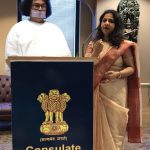Eid ul-Fitr is an important religious holiday celebrated by Muslims around the world. The month-long Ramadan fasting ends, with the sighting of the crescent moon in the sky and culminates the celebrations. When translated, Eid ul-Fitr means “festival of breaking the fast” and marks the end of the fasting month of Ramadan. English alternative terms and references for Eid are: fast-breaking Eid, sweet festival, Feast of Fasting, Small Eid, Eid feast, Sugar Feast, and Eid of happiness.
It is believed that Prophet Mohammad received the first revelation of Holy Quran during this month. The day of the festivity falls on the first day of the month of Shawwal. The date of Eid ul-Fitr typically varies from country to country, depending on whether the moon has been seen. The lunar cycle is used to calculate the Islamic Hijri era and this year’s Ramadan was observed at a different time across India, as the moon was not been visible in some parts of the country. Thus, the fasting was observed whether the moon was visible or not.
The Eid date remains a suspense till the last night as it completely depends on the sighting of the moon. If the moon is sighted Eid ul-Fitr is celebrated the next day. There are some sects that follow strict rules to establish that the moon has been sighted and rely on testimonies rather than scientific methods. On Thursday, June 14, after people break their fast, all eyes will be set on the sky to spot the moon. The crescent moon appears only for few minutes and if you miss the chance to spot it then you have to rely on sources.
Every year, the dates of Ramadan and Eid change – as the Muslim calendar, which began when Prophet Mohammad migrated from Mecca to Medina (also known as Hijr) in 622 AD – is based on the phases of the moon. As has been the case many times in past, Eid is celebrated on one day in some parts of the country, and on another day in others. This year, Eid ul-Fitr is expected to fall on June 15 or 16.
Traditionally, the celebrations begin at the first sighting of the crescent moon. If the moon is not sighted on the 29th day of the previous lunar month then Eid is celebrated on the following day. Fasting on the day of Eid is forbidden. The night before Eid is called ‘Chaand Raat’ which literally means ‘Night of the Moon’. People wake up early chant Salat ul-Fajr, followed by a breakfast before heading off to pray at a mosque or a prayer venue to perform special congregational prayers known as Salat al-Eid, consisting of two rakats. On their way to the prayer venue, Muslims also recite ‘takbir’ There is a tradition to distribute money among the poor. Eidi, gifts on Eid, are given to the children and immediate relatives.
In 2018, the young moon is expected to be seen on June 14, and for countries just west of the International Date Line – like the countries in far eastern Asia – the young moon sighting will likely be on June 15, as per EarthSky.org. Though every month, the date of a young moon sighting depends on multiple factors, but it mainly depends on the date and time of new moon. This month’s new moon falls on June 13 at 19:43 UTC (Coordinated Universal Time).









